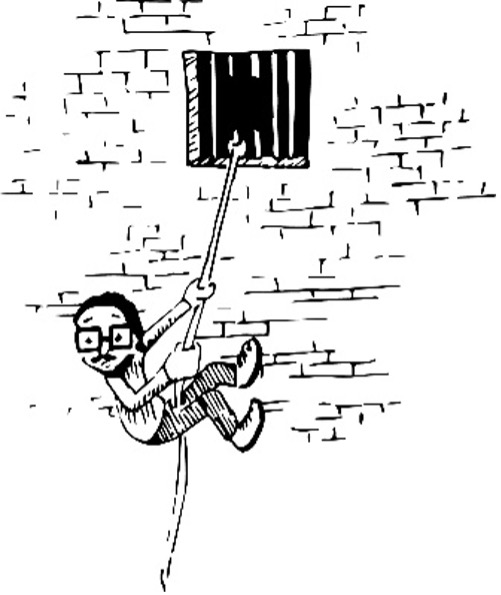
Pain is a very complex problem. It’s also such a common problem that every person on the planet will at some point in their life suffer its consequences, perhaps only a little, but for some unlucky souls, it will be life-changing for the worse.
Read & understand this five part series and you will have in your grasp the ability to reduce the risk of suffering severe chronic pain massively in your favour.
There are many factors which can affect the severity and longevity of the pain which is suffered. Many of those factors are in our individual control, so the good news is that each of us has the potential to dial in pain relief and reduce the impact of pain on our lives.
In this series of blogs, I will take you on a journey to help you gain a better understanding of pain and its causes, so that you will be able to reduce its consequences on your quality of life.
My Qualifications In Pain Relief
For me, the study of the cause and treatment of pain has been a lifelong journey. As a child I witnessed firsthand the suffering caused by long term severe pain, when my mother was bed ridden for years with back pain. My childhood also ended abruptly when I was handed many of the responsibilities and duties my mother could no longer fulfil.
I witnessed firsthand the inability of western medicine to effectively treat severe pain
At the outset, I had observed firsthand the inability of our western medical knowledge to effectively deal with severe pain and I thus vowed I would never restrict myself to the boundaries of western medicine alone. Why would I? After all, we all know that the best way to improve is to seek out those who excel. Thus, my outlook has always been broad rather than narrow, inclusive rather than exclusive.
At the outset, I had observed first-hand the inability of our western medical knowledge to effectively deal with severe pain and I thus vowed I would never restrict myself to the boundaries of western medicine alone. Why would I? After all, we all know that the best way to improve is to seek out those who excel. Thus my outlook has always been broad rather than narrow, inclusive rather than exclusive.
One reason chronic, or long term, pain has increased is that there has been too much focus on the localised injury and not enough on the significant contribution made by the nervous system and brain.
However, I would forever regret not communicating my knowledge on pain relief to you and at the same time potentially leaving you to suffer more than needed. Ultimately it is then up to each of you how you choose your own future pain relief journey.
Why do we feel pain?
Pain is a normal human experience, and we need it to survive. Pain is nature’s warning system which is designed to protect us. Pain is the symptom and not the cause of a problem.
When someone brings us bad news, we don’t shoot the messenger, do we? No, instead, we listen to what the messenger has to say, and then we go and find the real cause of the problem. It is exactly the same thing when it comes to pain. It is only trying to warn us that there is a problem, and it is up to us to seek out the true reason behind that pain. Where is the pain coming from and why? You can’t put a fire out if you don’t know where the fire is. Pain is no different.
Chronic pain has more to do with sensitive nerves and how your brain processes your lifestyle than the injury itself
Pain signals are sent to the brain for processing through the nervous system. Some nerves send control signals from the brain to the rest of the body. Others send signals from the body to the brain for feedback and processing. Each of us have around 45 miles of nerves connecting all our body parts to the spinal cord, so that provides a lot of opportunity for pain signals to be sent to the brain. The brain has to decide how to express that pain signal and that expression can vary wildly from one individual to the next.
As an example, I have seen patients with bone-on-bone contact in their knees and yet feel almost no pain, whereas others with far better cartilage cover suffer severely.
Our perception of pain is related to everything we are experiencing in our lives at that time. When we move better, eat better, are happier and less stressed, we minimise the pain we feel.
One secret to conquering pain is to find out what you have too much or too little of. It’s all about balance, and any disruption in the delicate balance of your body can be a strong contender for the root cause of your painful life.
If pain is suffered for too long, typically more than 3 months, the brain can hard wire it in. One reason chronic, or long term, pain has increased is that there has been too much focus on the localised injury and not enough on the significant contribution made by the nervous system and brain. In so doing, we have allowed the pain to be locked in the brain and no amount of localised treatment of where the pain is perceived to be felt will make any difference. Sadly, it’s not uncommon for perceived pain to be felt when the cause of the pain is in a different part of the body.
Emotional Trauma
An extreme example of locked in pain is when it has been caused by an emotional trauma many years earlier and often from as early as childhood. This trauma has caused a locked in physical condition which expresses itself as never-ending pain. The trauma and pain are intertwined so tightly that both must be released at the same time.
I have witnessed firsthand many such situations where the release of a muscle locked in spasm caused an emotional outflow and replay of the emotional trauma which was the root cause of the problem. This emotional venting led to a release from pain suffered sometimes 20, 30, 40 and even 50 years!
To summarise this necessarily brief introduction to why we feel pain, it should be clear that assessing pain is not a simple matter if the intention is to get to the root cause.
In my next blog in this series Your Pain Relief Plan Part 2 I will discuss the consequences of ageing and the differences between acute and chronic pain and why these need very different treatment protocols.
If you are currently suffering chronic, severe pain and nothing has so far helped, then our advice would be to get an appointment with Nicky asap. Nicky has helped thousands of clients get out of pain. Her reputation speaks for itself. Clients don’t travel from all of the UK and many from abroad without very good reason.
Don’t suffer any longer than you have to CALL NOW!
CALL 01889 881488. Jean, Erica or Charlotte will be happy to help
Call 01889 881488 Now
p.s. Don’t try to book online at this time as that is only suitable for existing clients already being treated for an existing problem.
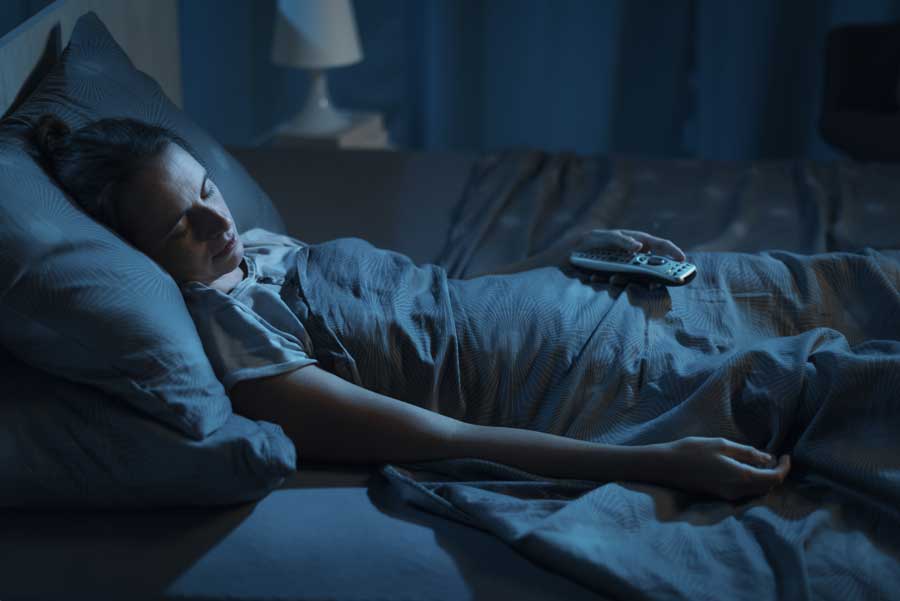
Who doesn't love the feeling of a good night’s kip?
Yet, many of us complain either of not getting ENOUGH sleep or good enough QUALITY of sleep to have us springing out of bed like a child on Christmas morning, ready to take on the day.
While sleep is far too complex a topic to sum up in numbers only, being aware of some of the basic statistics about sleep can help you to grasp just how prevalent a problem sleep deprivation is, and how a lack of Z’s can have a much wider impact on your health than you may expect.
the stats
- Approximately 10-30% of adults struggle with ‘chronic insomnia’, rising to 30-48% in older adults
- Women are 40% more likely to experience chronic sleep deprivation relative to their male counterparts
- 5 million Brits routinely have less than 5 hours of sleep per night
- Over £40 billion is lost to the economy annually due to sleep deprivation
- In a 2007 study of 10,000 people, those with insomnia were five times as likely to develop depression as those without.
- According to a 2004 study, people who sleep less than six hours a day were almost 30 percent more likely to become obese than those who slept seven to nine hours.
WHY IS SLEEP SO IMPORTANT?
Other than feeling energised and well rested, sleep is CRUCIAL for a number of our bodily processes, including ‘cognitive processing’ (the organising and retaining information), hormonal rebalancing and growth and repair, to name a few.
As physios, we are primarily interested in a hormone called ‘growth hormone’, which gets released into the blood stream during REM (Rapid Eye Movement) sleep to help repair soft tissue structures all around the body. Routine disruption to your sleep cycle therefore, doesn’t just leave you feeling dog-tired; it can also have a significant impact how well you heal from injury, and can adversely affect subsequent pain levels.
WHAT IS GOOD ‘QUALITY’ SLEEP?
The recommended number of sleep hours for the average adult is 7-9 hours, but why is this so universal?
Sleep as a process can be broken down into 4 key stages, with a whole cycle taking approximately 4 hours to complete. For optimal sleep, it is recognised that most people need to complete 2 full sleep cycles per night, ideally undisturbed!
When we consider 3am trips to the bathroom, snoring partners, pets in the bed, late night working, and too much caffeine, that earlier statistic doesn’t appear to be so shocking now does it?
So what can you do to set yourself up for sleep success?...
TOP 5 TIPS FOR A GREAT SLEEP
To set yourself up for a great night sleep, it’s best to think of easy and manageable changes you can make immediately to help your tune into your body and brain clock.
- Set a firm time for sleep and for waking
Setting a firm routine for when you go to bed and when you wake isn’t just for children. Following a set time, across a 7 day week, helps to tune your body and brain clock into a regular rhythm, signalling when it’s time to sleep and when to rise. After some time, this rhythm becomes engrained, making it automatic.
- Check your room temperature
When asleep, our body temperature naturally reduces by 1-2 degrees, therefore ‘overheating’ can be a common cause of sleep disruption. Turning your bedroom temperature down to an optimal 18 degrees avoids disturbance to your sleep by keeping your body temperature more stable.
- Utilise your sense of smell
Certain smells can help to induce sleepiness. Placing calming smells like lavender (pillow spray, essential oils) in the sleep environment / bedroom can help to trick your brain into winding down for sleep.
- Don’t eat at least 2 hours before bed
Ingesting food close to bedtime signals “wakefulness” to the body/brain, as there is now a need for food to be digested. Where possible, have your last mouthful 2-3 hours prior to sleep, which includes milk in coffee/tea.
- The two S’s rule
Your brain makes connections between spaces and activity. Try and utilise the bedroom for the two S’s - sleep and sex only. Where possible, keep laptops, iPads and mobiles out of the bedroom to limit the temptation for late night working/ scrolling.
If your poor sleep is due to Pain through back, legs, hips or neck for example then you can consider seeing a Physiotherapist at Pain Relief Clinic to help relieve this pain for more undisturbed sleep.
If you are stressed, then you can also consider a massage at our Stafford clinic.
If you found this article useful, check out our other health blogs,
also available on the website.
One of the first questions any patient asks when obtaining an injury is ‘how long until it gets better’... If only an answer were simple.
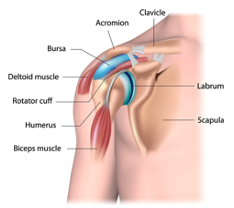
Unfortunately, when it comes to the shoulder joint, the answer isn’t straightforward at all because your shoulder is one of the most complicated joints in your body.
To achieve the wide range of movement that the shoulder provides, it requires a combination of muscles from body to shoulder blade (scapula), body to arm bone (humerus) and shoulder blade to arm bone. Due to this complexity, it is one of the most susceptible joints in the body to injury.
The shoulder is made up of three bones, the upper arm bone (humerus), the shoulder blade (scapula) and the collarbone (clavicle). There are joints between the clavicle and scapula and between the scapula and humerus.
The stability of the shoulder is predominantly controlled by four muscles, commonly known as the rotator cuff. They are tasked with keeping the joint properly centred and located.
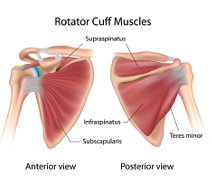 These are
These are
- Supraspinatus
- Infraspinatus
- Subscapularis
- Teres Minor
Common Shoulder Problems
The most common shoulder injuries are:
- Rotator cuff tears/tendonitis
- Impingement
- Instability
- Frozen Shoulder
- Bursitis
- Osteoarthritis
Rotator Cuff Tears
The rotator cuff muscles and tendons are an important part of the shoulder and are tasked with keeping the bones of the joint together across its wide range of motion. Rotator cuff tears account for more than 50% of shoulder injuries and are most common in people who repeatedly perform overhead motions. Thus athletes involved in sports such as swimming, racquet sports and weight lifting, which all require repetitive overhead movement, are particularly prone to injury.
Typical symptoms of a rotator cuff tear will be pain at night disturbing your sleep, and probably some lessening of pain during the day, although any overhead movement or even reaching behind your back is likely to be painful. You will also probably experience weakness in the affected arm. If left untreated, the pain will most likely increase over time.
Keen athletes may be tempted to continue in their favourite sport, in the hope that the pain will recede, but this will most likely aggravate the situation and, over time, may make the condition worse. If you suspect a rotator cuff tear, it is strongly advised to seek help from a qualified physiotherapist or sports therapist as soon as possible, as some conditions, such as a full-thickness supraspinatus tear, can become irreversible if left too long.
Impingement
Rotator cuff tendons can become trapped between a bony projection of the shoulder blade called the acromion and the top of the humerus (arm bone). Particularly prone is the supraspinatus tendon, this muscle is responsible for moving the top of the arm sideways from the body for about the first 15 degrees of arm movement.
Impingement problems can be caused by a number of factors, including:
- Loss of scapula – humeral rhythm
- Nerve interference or injury from the neck to the shoulder, causing abnormal movement of the shoulder
- Poor posture
- Tears and inflammation of tendons
Instability
Recent dislocation, sudden injury or overuse can each cause shoulder instability. The head of the upper arm bone can glide out of the shoulder socket (glenoid). This can occur when the capsule and ligaments that have the role of stabilising the shoulder in the socket have not healed properly and remain stretched making them too loose to keep the shoulder stabilised. This can result in repeated dislocations.
It is, therefore important to seek treatment. Rehabilitation and soft tissue work can be provided by qualified physiotherapists or sports therapists to help strengthen the muscles and ligaments and help to gain stability around the shoulder joint once more. It is advisable to seek help sooner rather than later.
Frozen Shoulder
This condition, medically described as adhesive capsulitis, can literally develop overnight. The capsule of the joint becomes inflamed and stiff, resulting in restricted movement. Eventually, the shoulder ‘freezes’ and becomes immobile for a few months to a year.
However, a frozen shoulder does typically progress in three main stages:
- Freezing stage- any movement of your shoulder causes pain, and your shoulder's range of motion starts to become limited.
- Frozen stage- pain may begin to diminish during this stage. However, your shoulder becomes stiffer and moving it becomes more difficult.
- Thawing stage- The range of motion in your shoulder begins to improve.
Bursitis
A bursa is a fluid-filled sac that act as a cushion to stop friction between the muscles and bones as they glide over on another. You have several in your shoulder, one being one of the largest in the body which is located towards the top of the arm.
After an excessive repetitive motion of the shoulder, the bursas can inflame and swell. The pain is normally a gradual onset located on the outside of the shoulder which can spread down the arm. It can become more aggravated when lying on the shoulder or if you’re using your shoulder anywhere from 60-90 degrees up and outwards.
When treating Bursitis, the aim is to control the inflammation. If you don’t seek help, often the pain will become worse and become impinged.
Osteoarthritis
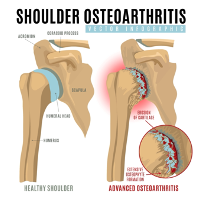 This is when the normally smooth cartilage that covers the ball and socket joint diminishes after constant friction leaving bone to grind against bone. It develops slowly and the pain worsens over time, normally after chronic wear and tear or work injuries. Symptoms may include swelling, pain, and stiffness.
This is when the normally smooth cartilage that covers the ball and socket joint diminishes after constant friction leaving bone to grind against bone. It develops slowly and the pain worsens over time, normally after chronic wear and tear or work injuries. Symptoms may include swelling, pain, and stiffness.
Osteoarthritis is a chronic problem which cannot be resolved, but the symptoms of the condition are amenable to pain-reducing treatment.
Every shoulder injury will present differently, and everyone’s perception of improvement will be different too. For example, one patient may be over the moon for gaining an extra 10 degrees in pain-free shoulder motion. Whereas the next will be happy only when gaining their full range of motion back.
Many biological, psychological, and social factors are involved during the recovery process after a shoulder injury.
If you are suffering from shoulder pain, we can help
Call 01889 881488 Now
Jean, Erica & Charlotte will be happy to help
The knee is the body’s largest joint and made up of four bones; the shin bone (tibia), the thigh bone (femur), a smaller bone on the outside of the leg (fibula) that attaches to the shin bone and helps support body weight, and the knee cap (patella). The knee joint is called a hinge joint, as it can bend, straighten and twist.
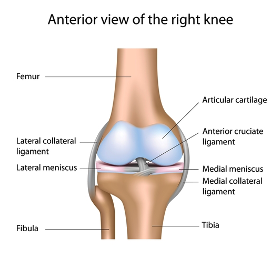
Each of the ends of the bones in the knee are covered in cartilage to protect the bones and let the joint move smoothly. Between the bones in the knee, there are 2 wedge-shaped pieces of cartilage, called meniscii. These are the shock absorbers and help cushion the joint from impact.
The knee joint is held together by ligaments which make the joint stable. There are four main ligaments in the knee. There are the collateral ligaments which run down the sides of the knee, which help to limit sideways movement of the joint and support against unusual movement. Then there are the cruciate ligaments, which are inside the knee and cross each other, to control back and forth movement in the joint.
Another factor in knee stability is muscles which also provide power and are the reason the joints can move. The knee is surrounded by strong muscles. The quadriceps are the front thigh muscles and they work to straighten the knee. If they are weak then this can lead to instability of the knee and kneecap. The hamstrings are the muscles on the back of the leg and their job is to bend the knee.
Which are inside the knee and cross each other, to control back-and-forth movement in the joint.
Another factor in knee stability is muscles which also provide power and are the reason the joints can move. The knee is surrounded by strong muscles. The quadriceps are the front thigh muscles and they work to straighten the knee. If they are weak then this can lead to instability of the knee and kneecap. The hamstrings are the muscles on the back of the leg and their job is to bend the knee.
Common knee injuries/conditions:
Knee ligament injuries – Normally from an accident, whether a slip, trip or fall. As mentioned above there are several different ligaments that support the knee. If you think you may have injured one, it is important that you see a Physiotherapist/Sports Therapist who can examine your knee to diagnose which ligament is damaged and how badly.
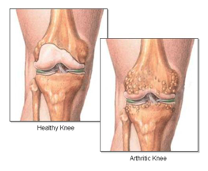 Osteoarthritis - wear and tear of the cartilage in the knee is called Osteoarthritis and is a common cause of pain. It may be aggravated by biomechanics, previous injury, overuse or the simple effect of years of living. Osteoarthritis symptoms can be relieved with orthotics, exercise and pain-relieving treatments.
Osteoarthritis - wear and tear of the cartilage in the knee is called Osteoarthritis and is a common cause of pain. It may be aggravated by biomechanics, previous injury, overuse or the simple effect of years of living. Osteoarthritis symptoms can be relieved with orthotics, exercise and pain-relieving treatments.
Cartilage injuries – often caused by sudden twisting, the cartilage between the knee can get damaged. If this is the case the knee needs strengthening and there may be a chance that surgery is required. It is crucial that you have a proper assessment to determine the best course of action.
The Impact of Leverage
When we can’t undo a tight nut, we reach for a longer spanner to give us more leverage. It’s a concept we all understand.
This same leverage principle applies to our knees as well because for most of the time the centre of our weight is not directly over our knees. Try looking sideways in a mirror and bend your knees and you will see that your knees are in front of the trunk of your body. Hence your body weight is applying leverage on your knees. As you bend your knees further, your knees get further in front and the leverage increases, just like using a longer spanner.
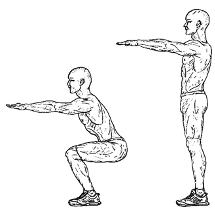
The implications of this leverage are that in normal walking your knees have to support 4 times your weight. If you crouch down it can go as 9 times your weight. No wonder then that if we carry excess weight, our knees will take the brunt of that, which means that knee problems are likely to be more likely with excess weight.
The good news is that most of us have the capability to do something about our weight. A simple change in diet and a bit more exercise is all it usually takes. And, of course, the motivation to do this.
Most common knee injuries in sports
The knees are frequently injured due to the stress of frequent starts, stops, twists and turns applied to the joint during exercise.
- The most common injury in the knee is knee ligament injuries. This normally occurs from an accident, whether a slip, trip or fall. The ligaments’ main role is to stabilise the knee so the knee might experience a sudden twisting motion, a rapid change in direction, or an incorrect landing from a jump. Sometimes you can hear a pop, or a snap followed by swelling and a loss of range of motion. It is important to see a physiotherapist/ sports therapist who can examine your knee to diagnose which ligament is damaged and how badly, so we can treat it sooner rather than later.
- Another common injury is to the meniscus (shock absorbers) of the knee. This can happen from general aging where the meniscus has become weak and tears after an awkward turn during normal day to day activities. Or it can happen during sports where the knee twists and pivots. You will normally feel pain, stiffness, locking and a decreased range of motion.
- Meniscus damage can take time to heal and can get worse over time if it isn’t treated properly by a physiotherapist/ sports therapist. It is crucial to have a proper assessment to determine the best course of action.
Overuse injuries are also common, including ‘runners’ knee’ or osteoarthritis.
- Runner’s knee is common in runners and cyclists. You often have dull pain around the front of the knee and can feel like a rubbing, grinding, or clicking sound in the knee cap. Your physiotherapist/sports therapist can help treat runners’ knee through a combination of massage and acupuncture. This will help relieve some of the pain and break that vicious cycle.
Looking after yourself and keeping healthy will most likely keep knees healthy too. Getting help sooner rather than later will also help massively with recovery time and getting you back to your day-to-day pain free activities.
If you are suffering with knee problems, you really need to see a physiotherapist/sports therapist sooner rather than later to correctly diagnose and then provide the best treatment possible.
Call 01889 881488 Now
Erica, Jean and Charlotte will be happy to help
A lot of you may have watched the commonwealth games this year and noticed a familiar location that the mountain bikers raced on. Cannock Chase has provided us with the opportunity to use this track whether to practice or cycle on for the experience. Whether you are interested in mountain biking over Cannock Chase, or road cycling and you want to do so while minimising your chances of injury, then here is some free advice given to you from our sports therapists at Nicky Snazell’s Wellness and Physiotherapy Clinic.
First, there are many ways to decrease your chance of injury and footwear is one factor you should consider.
Compared to running shoes, cycling shoes are designed with stiffer soles to help optimize your energy transfer. You should keep your foot rigid, so there’s no power lost through your feet and all the power from your legs goes directly into the pedal stroke. Additional support from clipping your shoes into your road bike will also help you to feel more secure when you are pedalling and can help prevent you from losing balance. It can also make you more aerodynamic as it has been noted that it is easier to get your torso lower toward your handlebars making you more streamlined increasing your speed.
That said, proper trainers are only part of the solution if you are struggling with any pain when cycling. Strengthening and conditioning the muscles in your legs and core region is essential for injury prevention. We can provide guidance, not only to stop and prevent pain occurring but to increase your cycling longevity and your performance.

What are the most common injury areas from Cycling?
The most common injury areas, more often due to overuse and poor technique are:
- Knee
- Lower back
- Neck
- Thigh
- Ankle
Specific diagnoses for these areas are:
- Anterior knee pain
- Lumbar or neck myofascial pain, a chronic condition affecting the muscles
- The iliotibial band running up the outside of the thigh
- Achilles tendonitis
If you are a keen cyclist, the chances are you have suffered from an injury throughout your training. Understanding how and why this is caused and taking steps to strengthen your weakness could be a game-changer for your performance.
Strength and Conditioning
The problem for many of us is that daily life can involve a lot of sitting at a computer screen all day and this can lead to poor posture and the important muscles in our trunk stiffening up and weakening. These core muscles, along with those in the buttocks and thigh are important tant in stabilising you during exercise. If these muscles become weak you are more likely to injure yourself from falls or strains.
What is Strength and conditioning?
The use of dynamic and static bodyweight and resistance exercises to improve your performance and reduce the likelihood of injury occurring. It is also used during injury recovery.
Why should I strength and condition?
- Injury prevention – helps to correct muscle imbalances and improve muscle activation, as well as increasing the efficiency of your running biomechanics which results in improved running performance.
- To be faster/ stronger
- To enjoy exercise more.
If this sounds like something you may need, book an appointment with one of our sports therapists to get the best possible guidance and treatment. As an athlete, you put so much effort into your training, it’s worth putting the effort into taking care of your body too. Prevention is just as important as recovery.
Call 01889 881488 Now
Erica, Jean and Charlotte will be happy to help
“Mr Roo referred me to you, said you are the clinic of last resort, as you fix problems others don’t or can’t, and he knows you will listen to me.
“I love my grandkids. I love my garden, I love to feed to birds, the hedgehogs, it’s my world, my life. Right now, I can’t do any of this because it’s agony and I don’t have a life.
I get phone calls from my doctor who prescribes drugs that don’t work. I have just seen a private surgeon at £19 a minute. He didn’t listen to me. I wanted help, I wanted him to listen, I wanted to know what I could do, who I should see. He just said nothing could be done with total disinterest, that surgery at my age was a waste of time and so was physiotherapy.”
Isn’t this sad? No one listened, no one gave her any hope.
“I have a scan, here, look, I don’t understand what it means. Can you help.”
This is what we did…………………
The scan showed a narrowing in a disc and some of it had squashed out like toothpaste, crushing a nerve in a rather arthritic little spinal joint. This little tiny part of her back meant she couldn’t pick up her grandkids, walk far, sleep or bend over gardening.
A detailed assessment showed us where the physical problem was, her general fitness and how she moved (her biomechanics). We needed to gently open up her locked-down spinal joint, quell the inflammation in her disc, and release the muscle contracture trapping the nerve.
Just as important as the physical treatment, we also needed to explain how other aspects of her health and mental stress were affecting her and her pain. To do this we explained the 4 Keys to Health: mindset, fitness, food and lifestyle and how a simple red, amber, green traffic light approach could help guide her to take the positive steps to better health. This in turn would help protect her from COVID and her pain.
We gave the patient her life back
After just 3 sessions she was no longer in physical pain and perhaps more importantly, had got her life back, comfortable in the knowledge that she had been listened to and that what was important to her had been understood. In her sessions, we gave:
- Advice on the relevant keys and how to move to 4 green keys.
- Counselling to reduce stress/ improve the immune response
- Laser to ease the pain and help reduce the inflammation.
- Electroacupuncture to reduce the pain and inflammation
- IMS dry needling to cut through fascia and remove muscle contracture, taking pressure off the nerves
- Exercise to help reduce the disc bulge with specific manual mobilisations and robotics
- Deep oscillation massage to soothingly reduce inflammation further
- Gentle hands on healing to further boost the response
If you are in pain, we can help
Call 01889 881488 Now
Jean, Erica & Charlotte will be happy to help
Our loyalty scheme has been a tremendous success and much loved since it was launched many years ago. Those of you who are familiar with this scheme will remember that we issued cards at reception which allowed you to record up to 10 loyalty stamps, one stamp for each appointment.
COVID then came along and threw a spanner in the works, as we were no longer able to issue cards for health reasons. This break, however, gave us the opportunity to rethink how the scheme could be improved both for you and us. We realised that we were in the process of installing some very powerful software and this, when operational, would allow us to develop a much more effective solution which would save you time on the phone and at reception.
We are delighted to tell you that our new software-based system is up and running and this means we can tell you almost instantly what your balance is on your loyalty account.
Didn’t Know We Had A Loyalty Scheme?
Well, Read On!
Now many of you who first joined us post COVID lockdown might not be aware we have a loyalty scheme and that you may have credit on your account. For those of you in this situation, this is how it works: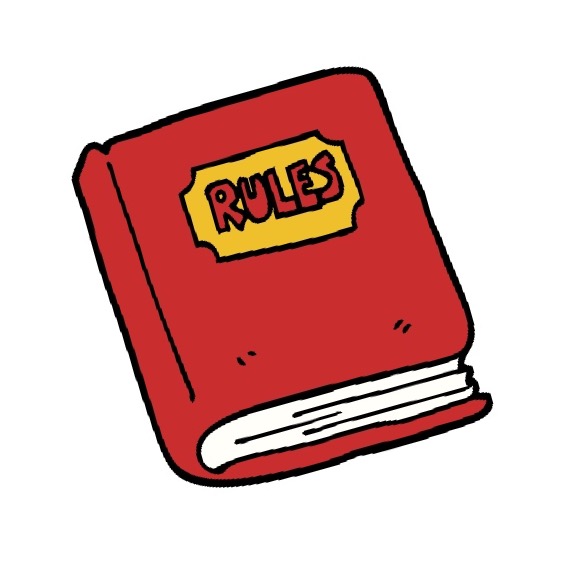
- You earn one loyalty credit for each appointment attended and paid in full
- Once you have 5 credits, you can exchange those in for a £10 discount on your next appointment.
- You can exchange multiple discounts at the same time. For example, 10 credits would get you a £20 discount and so on.
- Loyalty credits are not transferable or redeemable for cash
Our new system has been logging credits earned and exchanged since 1st July 2020, so fear not. Your account will be up to date.
Don’t Miss Out. Redeem Your Older Than One Year Old Credits Before 1st February 2023
We are taking the opportunity to update the rules of the scheme and from 1st February 2023, any credits which are over 12 months old will expire. Also, only credits earned since 1st July 2020 will be redeemable up to that date.
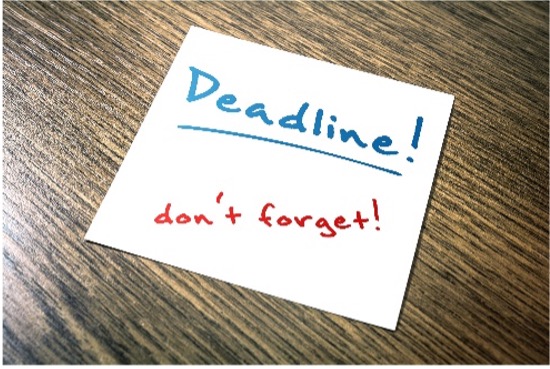
We are giving you plenty of time to use older credits earned between 1st July 2020 and 31st January 2022. Don’t miss out. Exchange them before 1st February 2023, or they will expire.
Still, Prefer The Cards?
The loyalty cards of old have been a very helpful reminder to many about their credit status, so much so that many may prefer to continue to get a card. No problem! We can give you a card if you wish, with the main log being available to you at any time from our software.
If you are in pain, we can help
Call 01889 881488 Now
Jean, Erica & Charlotte will be happy to help
Before I tell this story, I need to explain a bit about my background. I grew up in a scientific family, with a father and two brothers very much on the science rather than arts side of the seesaw. At school I was guided into science from the age of 13 and ended up studying engineering, just like my brothers. Since then, most of my working life has been in aerospace, surrounded by people who deal in facts and figures. In short, I had zero experience in anything spiritual and before this experience would have derided it as hairy fairy claptrap.
After leaving the aerospace industry behind in 2003, I chose to work as my own boss and started a health clinic business with Nicky my wife. She provided various treatment skills, including Physiotherapy and I provided the business background. Aware that I knew little about the health industry, I took myself back to college at Stafford for a year and subsequently to London for two and a half years, studying Chinese Medicine.
It is here my story unfolds.
My course work in London required many weekends and I soon got into the routine of travelling early Friday evening to London by train and then getting the tube from Euston up to Tufnell Park, where I then walked down Tufnell Park Road and stopped off at a clean and well-stocked shop halfway down, to get some tea, which I would eat at a fairly basic B&B.
This particular Friday, I was going to be unable to leave at my normal time due to work commitments, but I would still have no problem getting to the B&B at a not ridiculously late hour. That afternoon I mentioned to Nicky that I had had a vision a couple of times of being stabbed, which I put down to an overactive imagination and thought nothing more about.
I was keen to do some revision on the train, but this got interrupted by the stabbing image getting more and more frequent, to the extent it really started to spook me. I was in an interesting quandary as on the one hand, my scientific background told me it was just my mind stuck in a loop and couldn’t possibly be real. On the other hand, I was spooked, and any thoughts of studying went out of the window as fast as the scenery rushing past. By the time I made my way down to the Northern line platform at Euston I was contemplating going back up and getting a taxi direct to the B&B. It was my stomach that overruled that, as I needed something to eat and anyway, I was overreacting, wasn’t I?
My short tube journey to Tufnell Park, acted to intensify the feeling that I was going to get stabbed that night. As I stood at the corner outside the tube station, I forced myself to focus on getting something to eat. The later journey time meant that my favourite shop would already be closed, so an alternative was needed and there on the other side of the road was my saviour. Not as appealing as my normal haunt, after all I had seen it many times before and always written it off, but needs must, and it obviously sold food. I crossed the road where I had never crossed before.
My earlier impressions of the shop were fairly accurate, I bought up and decided that it would be my last visit. Outside I turned left and stopped to consider my walk to the B&B, which was about 5 minutes away. Next along from the shop was a GP’s Practice and between the two was a driveway to the back of the corner buildings.
I can only describe what happened then was like being overwhelmed by an intense surge of fear. I was instantly terrified and just wanted to get away. My senses were on full alert, and I was convinced that my visions were about to come true. I walked straight down the centre of the road, keeping maximum distance between me and any perceived danger points, like dark alleyways. It was difficult not to run, I was in full fight or flight mode, cortisol flooding my system and my heart racing.
I made it the B&B and couldn’t get into my locked room soon enough. I collapsed onto the bed to calm down, unable to face any food or fluid and went through multiple phases of relief. Eventually, I tried to make light of the whole experience and lent heavily on my upbringing and decided that I had been an overdramatic idiot.
After a fairly fitful sleep, I was relaxed. I convinced myself the whole thing had been imagination gone wild. I needed to get to Camden Town, and this meant retracing my steps back to Tufnell Park tube station.
As I got to the tube station, I looked across to the GP surgery and corner shop. The gap between was cordoned off by Police tape. An unlucky soul had been murdered there the night before. He had been stabbed.
An Epitaph
I have no memory of having any kind of similar experience to this before this event. It’s not impossible though, because nearly everybody I knew would have laughed in my face if I had suggested such a thing. It’s highly likely that being married to Nicky, observing her skills and listening to her beliefs, has opened a door in me that I didn’t even realise existed.
I cannot rub out this experience. It happened. Why did it happen to me? Who knows? But without a shadow of a doubt, I picked up on a stabbing more than eight hours before it occurred and from more than 100 miles away. I have no idea how this happened.
Has it happened again? Only once and nothing so significant, although it could have been. Nicky and I regularly drive to Norfolk and not being keen on the boredom of motorways and the A14, we have created a very nice cross-country route, which takes us through some very pretty countryside and allows us to stop halfway at a nice pub in Corby Glen. The route takes us across the A1 and through Colsterworth, famous for being the birthplace of Newton. One night we approached a crossroad in Colsterworth, with the road on the left being concealed behind houses. Although we had right of way, I braked hard suddenly before the junction and shouted to Nicky a car was going to come straight across in front of us. Seconds later a car shot out from the left and went across the road in front of us, travelling at a speed that would have caused a serious accident if we had been in the way. We would have been if I hadn’t braked.
I can’t explain any of this and no doubt many would try to fob it off as a couple of made-up stories, because they would have no basis to justify belief. I understand and sympathise with this, after all I would have done exactly the same before these experiences.
My view is that the life that most of us lead, the information we are given, the environment we are provided for most of us all provoke disbelief of anything intangible.
It is only the rare personal experiences of the tiny few that allows a different perspective to be even considered.
For me, I cannot possibly return to the majority belief. Will any more events like this occur for me? I don’t know. I will be disappointed if they don’t.
Alan
If you are in pain, we can help
Call 01889 881488 Now
Jean, Erica & Charlotte will be happy to help
One autumn morning last year, a quiet, middle-aged clinical professor came to see me because he found his gym workout was badly irritating his elbow and ankle.
I went over my 4 Keys (see my book) healthy living questions, to which he scored green in food/ water/ supplements and fitness. He scored amber in lifestyle – he was working a little too much. Family life had been fraught with problems until recently, and on the whole, he loved his work. He just couldn’t quite get his life/work balance right. His mind was amber and at times red, as he found teaching at university stressful, and he also found it difficult to switch off. I intuitively sensed some deeper issues, and it made sense that keeping fit calmed his mind.
“I haven’t injured myself or upped my workouts or done anything to cause these pains; they’ve just crept up on me. My pain is deep and aching, not sharp, and I haven’t done anything to cause it,” he stated, at a loss as to why this was happening to him.
This made me decide to explore his physical body for chronic [neuropathic] pain and to explore the deeper spinal muscles and relevant joints and ligaments. It seemed wise to leave the alternative discipline of shamanic reiki till later. This aspect of healing needs a deeper level of understanding and trust between practitioner and patient.
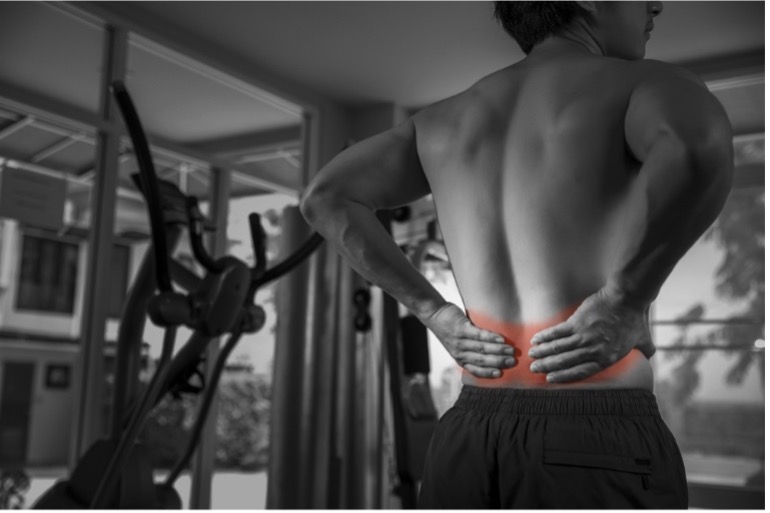
I could feel that his lower back was tighter on one side This could have been disc irritation, or it could have been his biomechanics, the way he sits and walks, and either a fixed or habitual posture. Telltale signs of collagen lines at the base of his neck and back suggested a thinning of the underlying discs. His buttock was acutely tender. His hamstring was slightly tenser, with sensitivity being increased again over the division of the sciatic nerve at the back of the knee, tight bands in his calf muscles, and a moving tenderness where his ankle flexors wove around his ankle.
This was all pointing to neuropathic changes to his L5 nerve root at the base of his spine. That means the sensitivity of the nerve root due to poor posture or ageing disc, as well as mild peripheral nerve changes, causing small contractures down the limb and his ache.
This type of problem is insidious and is often a normal part of ageing related to postural issues, causing disc narrowing, called spondylosis, and subtle changes to nerves, from very mild to severe neuropathy.
The symptoms can be anything from mild stiffness to pins and needles, numbness and various degrees of sharp burning and aching pains, often made worse on exercising.
Edwin needed a combination of treatments and skills to help resolve his problems. Over two treatments I gave him GunnIMS to relieve the deep-seated muscle problems at the base of his neck and back, plus acupuncture, laser, joint mobilisations and deep oscillation. I also used NLP and subtle mind mapping to get his head in the right place.
Ideally, I would have gone on to add shamanic reiki to heal issues in his auric body, balance his chakras, and use key acupuncture points in his fascial plane. However, after two treatments he was physically pain-free and elected to get on with his life.
If you are suffering long-term pain, and maybe even tried some treatments which have not helped, then it might be because the cause is more complex than first thought. Physical symptoms can manifest themselves due to a whole range of reasons, from mental to nutritional to physical, including neuropathic (nerve-related), or a combination of some or all these causes. It thus requires a deep and broad assessment to be able to create a successful treatment plan and positive outcome.
If you are in pain, we can help
Call 01889 881488 Now
Jean, Erica & Charlotte will be happy to help
Great news. The sun is shining, and it’s holiday time!
Hydration Questionnaire:
- Do you rarely have thirst / dry mouth?
- Do you rarely get headaches?
- Is your urine a mild (not dark) yellow colour?
- Are your skin and lips moist, not dry?
- Do you have regular bowel movements most days?
- Do you have less than two glasses of alcohol a day?
- Do you have five helpings of fresh fruit and vegetables a day?
- Do you have several glasses of fruit water / juice / herbal teas a day, even if resting?
- Do you avoid having too many salty snacks?
Score 1 for each Yes. Total 0—3 Red, 4—6 Amber, 7—9 Green. Get Nicky’s ‘4 Keys To Health’ book for more information.
Here is some simple advice to help you avoid ruining your holiday
What happens in a drought?
A hose pipe ban, a car wash ban, shorter showers, and less water in the bath. We all protect the vital stuff, like making sure we and our animals get water. Fortunately, we live in a country with more than its fair share of rain and our droughts don’t last too long, so a drought tends to be more of a temporary irritant than a serious problem.
 But what if a drought did last for a long time? What would happen to our gardens if they hardly ever got watered? Well, a lot of very poorly and dead plants and lawns that wouldn’t win any prizes for sure.
But what if a drought did last for a long time? What would happen to our gardens if they hardly ever got watered? Well, a lot of very poorly and dead plants and lawns that wouldn’t win any prizes for sure.
It’s doubtful anyone would argue with the above in principle. After all, it’s stating the blindingly obvious.
If it’s so obvious then, why is it that at least 75% of us and maybe as many as 90% are long-term dehydrated? Given that plants left dehydrated long-term will get weak and die, then it should come as no surprise that our complex bodies are likely to suffer the same fate. Why do we put ourselves at this risk?
Your body will start to react to dehydration with as little as a 1% drop in availability, and a priority system will start to kick in. Your brain needs a lot of water and your organs' functions are vital. These will get priority because these are more critical to life. Non-critical body parts will get a bit of what is left.
Up To 90% Of Us Are Dehydrated.
The list of potential problems from dehydration are huge and are linked to many diseases. The implication to overall wellness is obvious—stay dehydrated at your peril. As a clinic which treats patients every day with pain and injury, here are some dehydration issues we see:
- Just about every joint in your body has cartilage, which needs to be kept hydrated to stay healthy. Dehydrated cartilage will promote inflammation, pain and arthritis.
- Spinal discs need to stay moist and supple. Without adequate hydration this could cause a multitude of spinal problems.
- Muscles will cramp, swell, become tender, have reduced strength and possibly suffer tissue damage.
- Dehydrated tendons and ligaments can make you more prone to injury, pain and inflammation.
Long-term dehydration is clearly serious and is linked to many diseases. So why are we so prone to dehydration when it is so easy to fix?
Your Body Has Drought Management
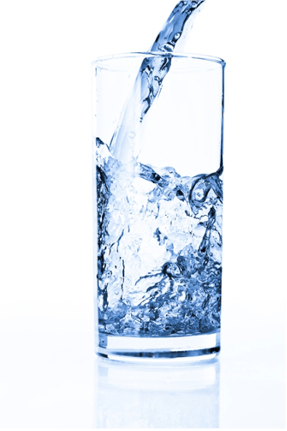 Many studies have shown that what we drink is just as important as how much we drink. In the UK caffeine-loaded beverages like coffee, tea and soda’s are prevalent. In fact, most of us don’t drink water at all.
Many studies have shown that what we drink is just as important as how much we drink. In the UK caffeine-loaded beverages like coffee, tea and soda’s are prevalent. In fact, most of us don’t drink water at all.
The problem with caffeine, if concentrated, is that it is a diuretic which in many cases stimulates us to lose more water than we consume in the drink itself. Thus, drinks like this act to dehydrate, not hydrate. It makes it worse.
This issue is contentious and we have to accept that many arguments will have a financial motive. But let’s use common sense. Most people in the UK drink tea and coffee as their main source of fluid intake. If these drinks are not diuretics, then how come nearly 90% of us are dehydrated?
There are many social factors which prevent adequate fluid intake as well. People whose environment does not provide easy access to a toilet, such as drivers for example, are very prone to low fluid intake.
A further factor is with the elderly, who simply don’t register they are thirsty in the first place, plus don’t want to drink too much to reduce visits to the loo.
Here are some simple guidelines on 'how to stay properly hydrated'
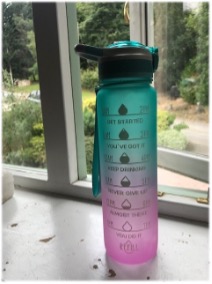
- Drink water as well as diuretic drinks. Recommendations vary but aim for about 1.2 litres per day
- First thing in the morning drink a big glass of water, not tea or coffee.
- If you are feeling hungry, maybe you are thirsty. Drink some water first as that quenches hunger.
- If you are feeling lethargic during the day, drink some water. Lethargy is an early sign of dehydration.
- If you get a bit of heartburn, try a glass of water first.
I use a water bottle which shows me how much water I need to drink all through the day. It gives great feedback, as it’s easy to see when I’m not drinking enough. A really simple and great idea.
If you are in pain, we can help
Call 01889 881488 Now
Jean, Erica & Charlotte will be happy to help
